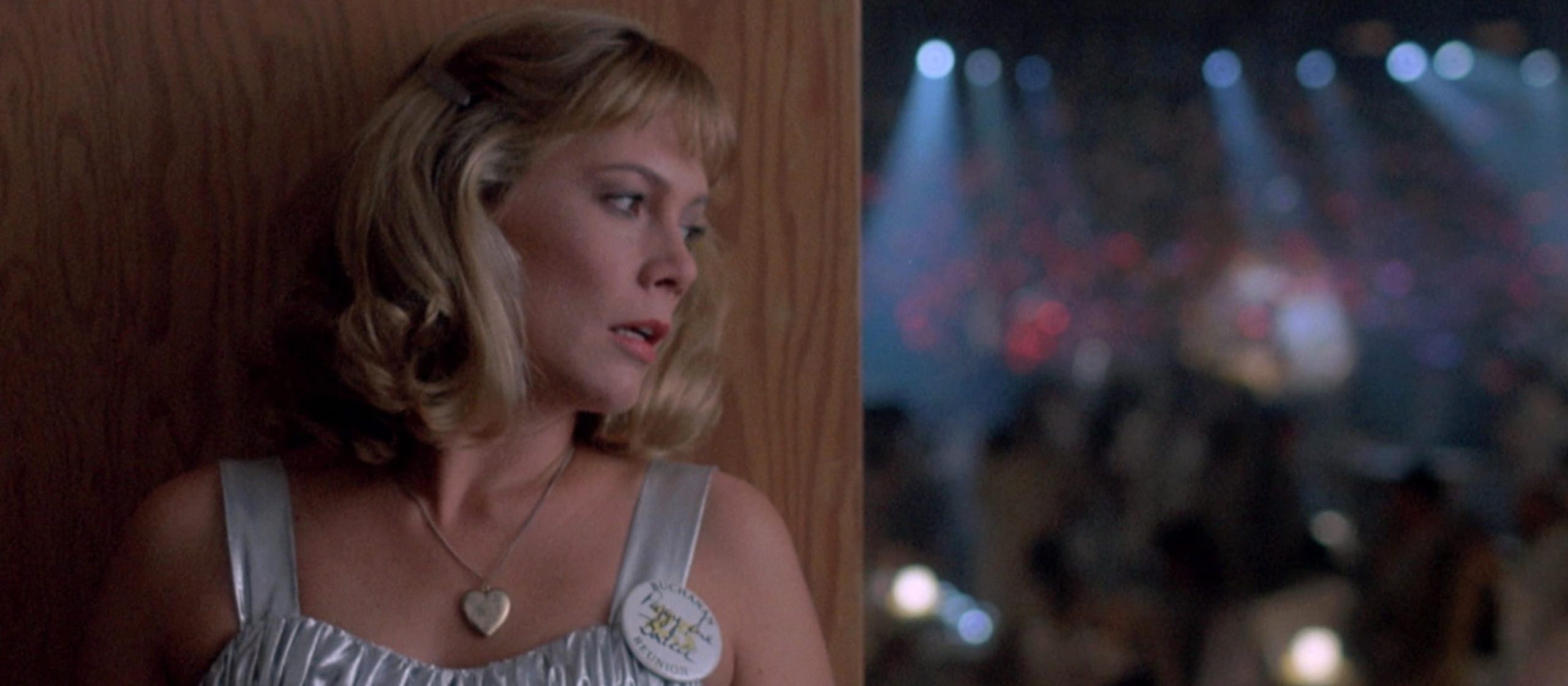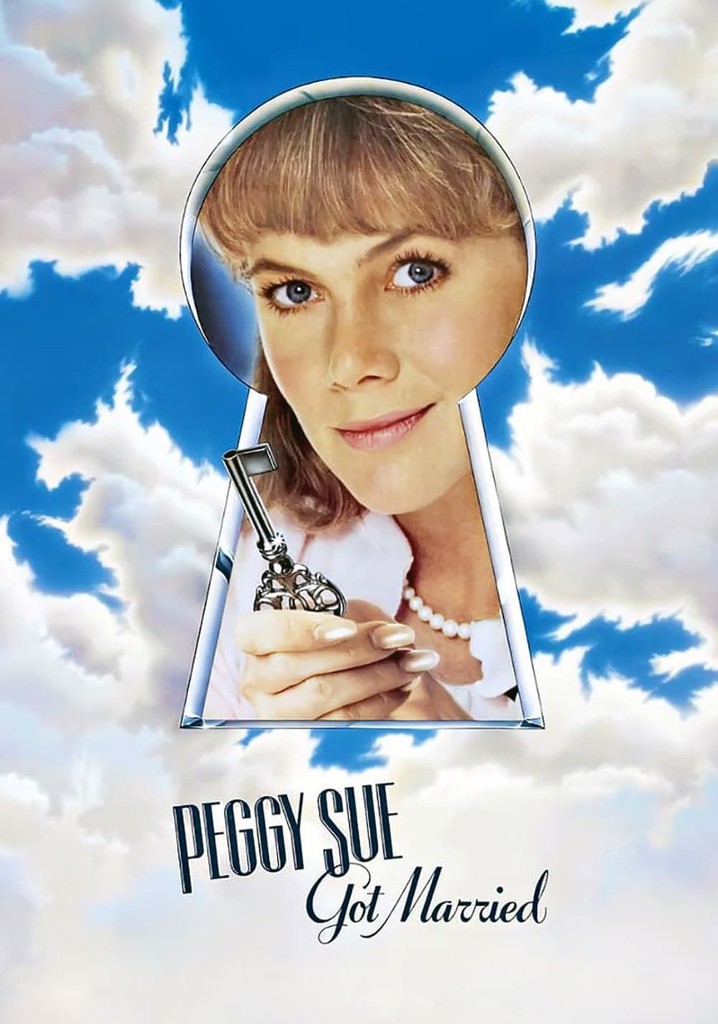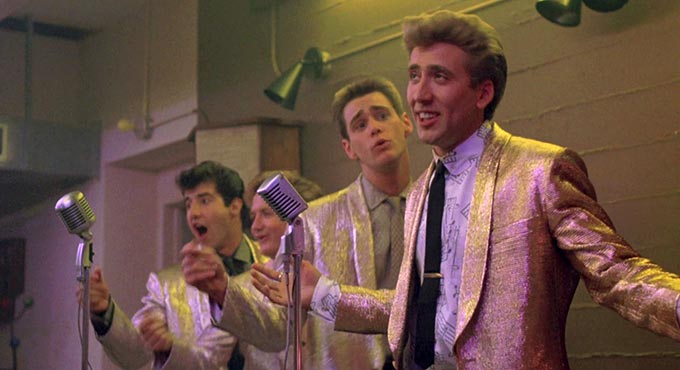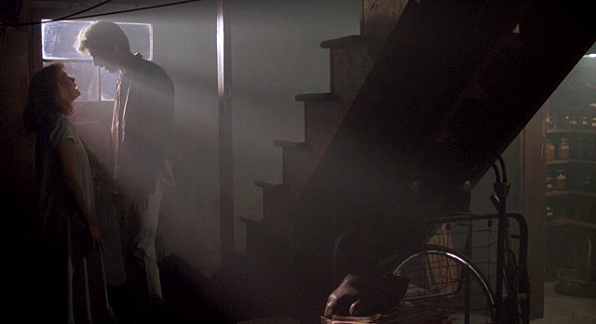

“What’s the fun of being a teenager if you can’t dress weird?”
As far as sticky-sweet nostalgia binges go, Peggy Sue Got Married is more than adequate. Time travel, romance, classic cars, poodle skirts, pompadours, barbershop quartets, baton-twirling cheerleaders, the whole nine yards; it doesn’t skimp on its trappings, and Francis Ford Coppola is a consummate pro behind the camera: note the faux-mirror tricks that bookend the film, signaling and echoing its dreamlike themes.
At the center of it all is a compelling, Oscar-nominated performance from Kathleen Turner in a multifaceted role that sees her forty-something mother of two on the verge of divorce magically transported back to her senior year of high school, where she’s granted the opportunity to change the direction of her life.
Unlike other similar films of its era—time travel was in vogue at the time, with Back to the Future coming out the prior year—Peggy Sue Got Married is decidedly noncommittal regarding its mechanics. Peggy Sue, voted queen of the night at her twenty-fifth class reunion, becomes overwhelmed while accepting her crown, swoons, and bonks her head. Voila, she’s back in 1960, faint from having donated blood. Understandably confounded, she quickly warms to the idea of having a do-over, and each successive rediscovery of the mundane pleasures of her youth brings new waves of deep satisfaction.
She accepts her situation so quickly, in fact, that once she settles into the groove of her new-old life, there isn’t much by way of conflict to drive the story. Sure, there’s a little bit of drama as she mulls over whether or not she should stick with Charlie (Nicolas Cage), an aspiring singer who will give up his dream to become a seedy electronics salesman, or pursue the beatnik Michael Fitzsimmons (Kevin J. O’Connor), who will become a famous writer. There’s a minor subplot involving the Nerdy Richard Norvack (Barry Miller), who believes her story and eagerly jots down all the stray bits of future technological innovation that Peggy Sue can call to mind. There’s petty drama amongst the girls (Catherine Hicks, Joan Allen, Lisa Jane Persky, Lucinda Jenney), some jokes with the guys (an early-career appearance from Jim Carrey) and a few instances where Peggy Sue exploits her foreknowledge or acts more boldly than she would have in the past (day-drinking from her father’s bottle is a particularly funny bit). But by and large, Jerry Leichtling and Arlene Sarner’s story simply luxuriates in Peggy Sue’s meandering journey of nostalgia and self-rediscovery, with particular emphasis on the quieter moments: when she insists that her younger sister (Sofia Coppola) play a board game with her; when she remarks that she had forgotten that her mother was “ever this young”; when she hears her grandmother’s voice over the phone. All of this wide-eyed sappiness hangs on Turner’s shoulders, and she certainly delivers, moving from disbelief to melancholy to mischief with aplomb.

If all Peggy Sue Got Married amounted to was sentimental melodrama, it would still be an acceptable picture, if a minor work in its genre and its director’s oeuvre. But not only does such a dismissive attitude overlook its technical merits (Jordan Cronenweth and Theadora Van Runkle were nominated for Oscars alongside Turner for cinematography and costume design, respectively), it also misses its best feature: Nicolas Cage’s deliciously strange performance. (Maybe “best” is not the correct word here… most noteworthy?) Cage, a nephew of Coppola who had changed his name to avoid the appearance of nepotism, reportedly turned down the role numerous times before accepting on the condition that he could “go really far out with the character.” His uncle agreed. And so, rather than match Turner’s serious portrayal, Cage is “Crazy Charlie,” a goofy weirdo who speaks “like Pokey from The Gumby Show,” pretends to suck his girlfriend’s blood like a vampire, at one point deliberates smothering her with her own pillow, and eats rice krispie treats like an alien awkwardly mimicking normal human behavior. While Cage’s career has become synonymous with his outlandish portrayals, it’s important to note that at this point the 21-year-old had only a few credits to his name and two of them had come from Uncle Francis (Rumble Fish and The Cotton Club). And many of those crazy roles are couched within crazy films. Peggy Sue Got Married is emphatically not crazy, which makes Cage’s manner of speech all the more captivating. The highlight of his oddball performance comes when Peggy Sue tries to seduce Charlie in the confines of his parked car. “Doesn’t Lucky Chucky want to come out?” she asks him. “Who?” he says. “You know, your love machine. Your throbbing thrill hammer. Your thing.” Cage pauses, the gears are spinning, but he’s already half caught in the heat of the moment. Breathing heavily, he manages to say, “You mean my huh-wang?” I’ve seen the film three times now, and it’s blatant potty humor, but his delivery gets me every time.

Cage dominates the weird side of Peggy Sue Got Married, but there are several other tangents that travel into strange territory unbecoming of the standard romance that it initially looks like. Take, for instance, Michael’s assumption that after a one-night fling, Peggy Sue has tacitly agreed to travel with him to Utah where he plans to settle down with her and another girlfriend where polygamy is legal. Or how, when Peggy Sue is ready to go home, she enlists her freemason grandfather to take her to a lodge where he and his fraternity brethren perform a time travel ritual. Hanging in the balance somewhere between screwball comedy and a sentimental drama, Peggy Sue Got Married never quite finds its footing, but Turner is so committed to the material, Cage so fascinating in his deliberate sabotage, and Coppola so canny behind the camera, that it’s hard to to resist its appeal.
Sources:
Byrne, Suzy. “Nicolas Cage didn’t want to make ‘Peggy Sue Got Married’: ‘I must have said no 5 or 6 times’”. Yahoo. 7 August 2019.